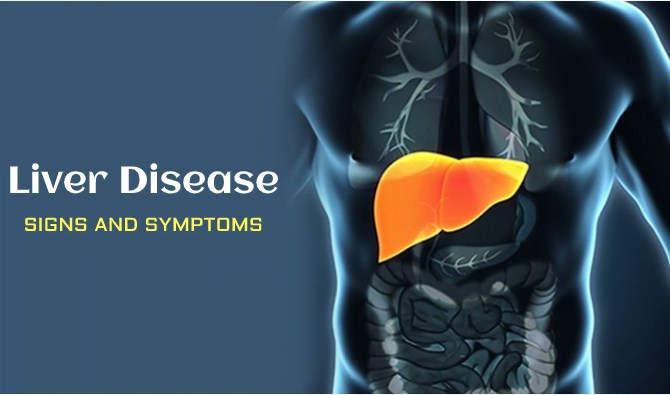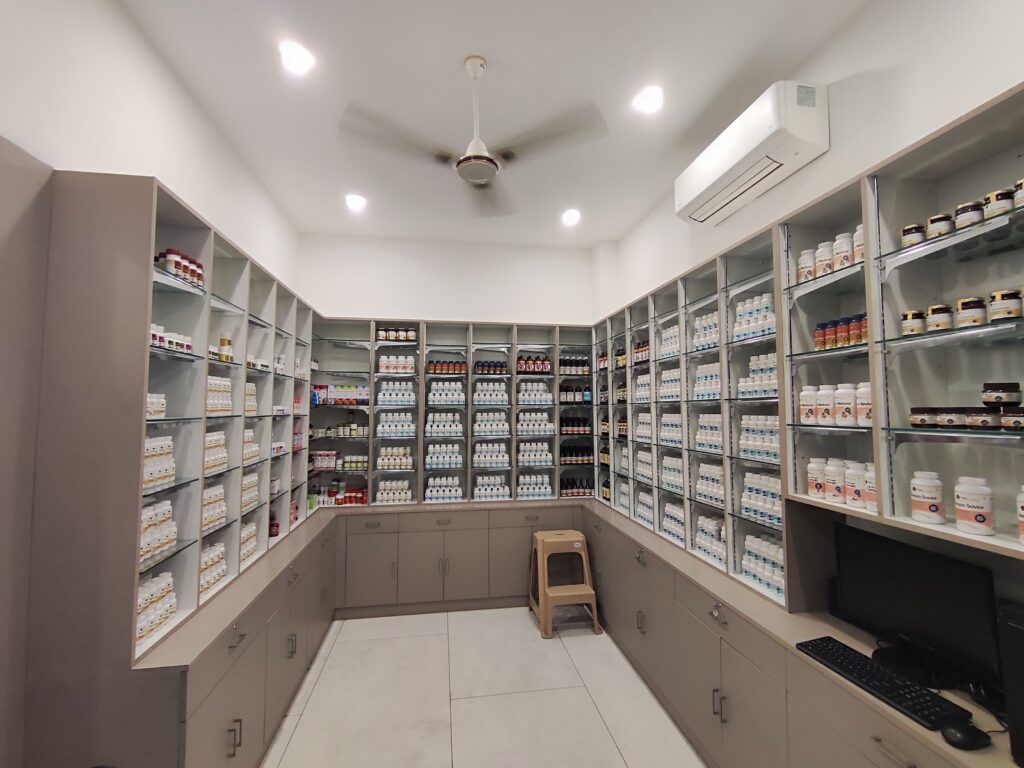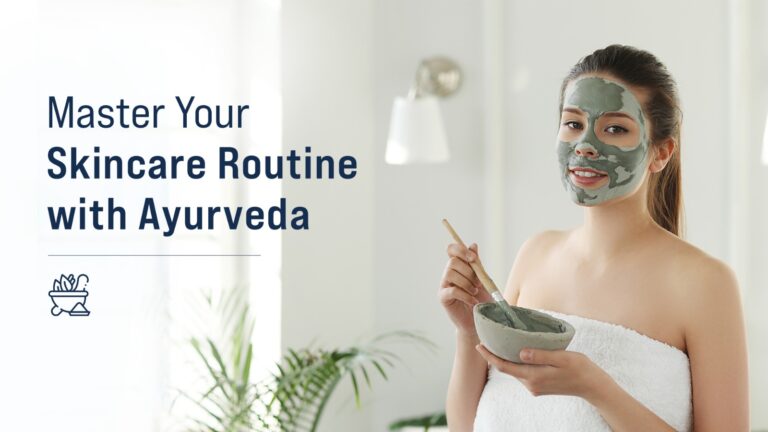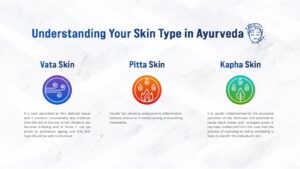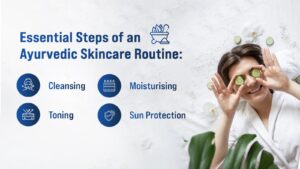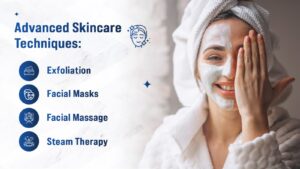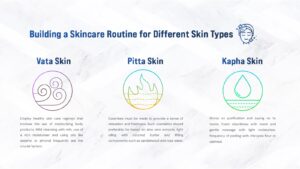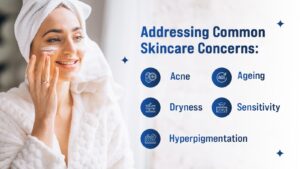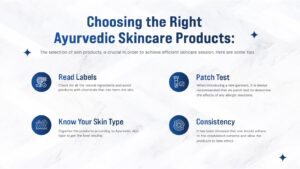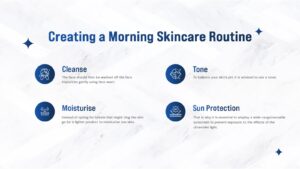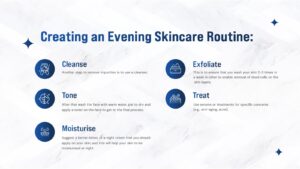Understanding Your Skin Type in Ayurveda:
The skin types are identified by Ayurveda by a classification of three doshas. The three doshas are called as Vata, Pitta and Kapha. It is beneficial to learn about one’s dosha and apply this for the construction of a skin care plan.
Vata Skin: It is best described as thin, delicate tissue and it contains considerably less moisture than the rest of the skin. In hot climate it can become irritating and at times It can be prone to premature ageing and this skin type should be well moisturised.
Pitta Skin: Usually fair, sensitive, and prone to inflammation, redness, and acne. It needs cooling and soothing treatments.
Kapha Skin: It is usually characterised by the excessive secretion of oils, thickness and potential to cause black heads and enlarged pores. It has been evidenced from this case that the process of cleansing as well as exfoliating is likely to benefit this individual’s skin.
Identifying your Ayurvedic skin type is the first step in crafting an effective skincare routine.
Essential Steps of an Ayurvedic Skincare Routine:
The Basic Steps: The skincare standards which are used in Ayurvedic treatment processes are aimed at achieving optimization of the human body state and using natural ingredients
Cleansing: For this step, it is necessary to use a gentle natural wash to wash off the skin surface without damaging the skin oils. One should use only milk or cream based cleanser for Vata dosha, rose water or aloe vera based cleansers for Pitta dosha and neem based cleansers for Kapha dosha.
Toning: Toning prepares the skin to the next step by helping it to regain its pH balance after washing. There are some cures which would be helpful for all the three doshas such as rose water.
Moisturising: Wash your face with water of your appropriate dosha type. Vata skin type should use sesame oil, Pitta skin type should use coconut oil and the Kapha skin type should use oils like sunflower oil or flaxseed oil.
Sun Protection: obey the sun and use natural products to cover the skin. That will make wheat germ oil have to be added in a couple of drops with aloe vera gel that can work nicely.
These skin care steps form the foundation of a healthy Ayurvedic skincare routine.
Advanced Skincare Techniques:
Exfoliation: Facial scrubs can be massaged on the skin; one or two times a week to assist in working them on the skin’s surface hence stimulating cell turn over and eliminating dead skin cells. It would be preferable to make natural scrubs like oat flooring or gram flour.
Facial Masks: Facial mask should be used at least once a weak depending to type of the skin and problem, which you want to solve. Some natural products like turmeric powder, honey, and clay recommended in Ayurveda may also act. For Kapha skin it requires multani mitti (Fuller’s earth); for Pitta, soap should be prepared from sandalwood; and for Vata skin – from yoghourt mixed with honey.
Facial Massage: You may also need to administer face massages in your timetable; they assist in revival of circulation in the skin and are also relaxing. Apply upward strokes and natural herbal oils and butters appropriate to the Doshas: Sesame to the Vata types, Coconut to the Pitta types and Almond for Kapha types of people.
Steam Therapy: Treat your face to a steam once a week in order to open the skin pores so that the beauty products can get into the skin. This can be done by adding some soup ingredients like neem or basil leaves or eucalyptus to the water for more advantage. These are some among the procedural measures that can be put in place to improve on the feel and look of skin to give it a better outlook.
Building a Skincare Routine for Different Skin Types:
Vata Skin: Employ healthy skin care regimen that involves the use of moisturising body products. Mild cleansing with milk, use of a rich moisturiser and using oils like sesame or almond frequently are the crucial factors.
Pitta Skin: Essentials must be made to provoke a sense of relaxation and freshness. Such cosmetics should preferably be based on aloe vera extracts, light oiling with coconut butter and lifting components such as sandalwood and rose water.
Kapha Skin: Stress on purification and saying no to toxins. Foam cleanliness with neem and gentle massage with light moisturiser, frequency of peeling with chickpea flour or oatmeal.
These tailored skin care steps will help you build an effective routine for your specific Ayurvedic skin type.
Addressing Common Skincare Concerns:
The Ayurveda system of treating proposes different remedies for the different skin ailments. Acne: When applied in areas infected with antibacterial such as neem to wash the infected skin. The patient should use cosmetics, which are specially formulated for the face, avoiding comedogenic ones, and refrain from using too much oil. Incorporate turmeric mask to reduce inflammation of the tissues.
Ageing: Use products that have antioxidant such as Amla and Gotu Kola. This alongside the facial massage as well as the use of serums especially those that contain hyaluronic acid should also not be left out.
Hyperpigmentation: Use natural bleaching materials and some solutions such as glycyrrhizin, which is obtained from the root of licorice and lemon juice. Peeling of skin and application of powdered turmeric mask also helps to reduce the production of the dark coloration on the skin.
Dryness: Some of the most suggested products are those that are highly intense and packed with honey and aloe vera contents. Avoid using hot water and the strong solutions of alkalis. Sensitivity: While choosing herbs, it is desirable to select such ones that will help to relax and get nourished; it can be rose water or calendula. Kindly no scented items and chemicals are allowed.
An answer to these concerns with certain measures of Ayurvedic skin care shall be useful in solving the existing issues and improving the skin state.
Choosing the Right Ayurvedic Skincare Products:
The selection of skin products is crucial in order to achieve efficient skincare session. Here are some tips:
- Read Labels: Check for all the natural ingredients and avoid products with chemicals that can harm the skin.
- Patch Test: When introducing a new garment, it is always recommended that we patch test to determine the effects of any allergic reactions.
- Know Your Skin Type: Organise the products according to Ayurvedic skin type to get the best results.
- Consistency: It has been stressed that one should adhere to the established patterns and allow the products to take effect.
The following skin care steps will assist you in purchasing the appropriate Ayurvedic products.
Creating a Morning Skincare Routine:
It also needs to be marked that morning caring for skin is aimed at preparing the skin for the day. Here are the essential steps:Here are the general procedures that must be followed:
- Cleanse: The face should then be washed off the face impurities gently using face wash.
- Tone: to balance your skin’s pH, it is advised to use a toner.
- Moisturise: Instead of opting for lotions that might clog the skin go for a lighter product to moisturise you skin.
- Sun Protection: That is why it is essential to employ a wide-range/versatile sunscreen to prevent exposure to the effects of the ultraviolet light.
Just, if all these Ayurvedic skin care steps are followed in morning then for the whole day skin will remain protected and healthy.
Creating an Evening Skincare Routine:
An evening skin care is therefore a skin care regime that works to nurture the skin as it heals at night. Here are the steps that one has to take in order to execute such an order correctly:
- Cleanse: another step to remove impurities is to use a cleanser.
- Exfoliate: This is to ensure that you wash your skin 2-3 times in a week in other to enable removal of dead cells on the skin layers.
- Tone: After that wash the face with warm water, pat to dry and apply a toner on the face to get to the final process.
- Treat: Use serums or treatments for specific concerns (e.g., anti-aging, acne).
- Moisturise: Suggest a better lotion, or a night cream that you should apply on your skin, and this will help your skin to be moisturised at night.
Here are the Ayurvedic skin care steps, which will enable the skin prepare for the next day activities appropriately.
Skincare Tips for Different Age Groups
Caring for the skin is one of the most vital things and it varies with the advancement in age. Here are some Ayurvedic tips for different age groups: Here are some Ayurvedic tips for different age groups:
- Teens: Concentrate on washing, nourishing, and protecting. Tackle acne with mild products such as neem and turmeric.
- 20s: Begin using antioxidant and minimum levels of exfoliation. Have a reasonable business schedule and use organic foods in the meals served.
- 30s: Recommended products should be anti-aging products like the amla and Gotu kola. Stress on how much water one is taking and making sure you spend most of your time under a shade or an umbrella.
- 40s and Beyond: Use richer, hydrating products. Incorporate anti-aging treatments and regular exfoliation. For more serious issues, it is recommended to consult professional services of Ayurveda.
This means that, you need to prepare your skin care routine depending on your age in other to have a healthy and glowing skin.
Conclusion: Achieving Healthy, Glowing Skin with Ayurveda
Mastering your skincare routine, numerous things are involved including the identification of the Ayurvedic skin type, essential and the advanced skin care regiment as well as selection of the right products. Skincare according to Ayurveda is natural and follows a holistic approach because it is a system of healing that aims at finding balance. Thus, with regard to the enumerated guidelines and trying to follow the individual pattern of daily activities, it is possible to maintain healthy and youthful looking skin at any age.



